-
 Bitcoin
Bitcoin $95,455.1015
-0.66% -
 Ethereum
Ethereum $1,829.9821
-0.01% -
 Tether USDt
Tether USDt $1.0001
-0.04% -
 XRP
XRP $2.1882
-0.48% -
 BNB
BNB $593.2356
-0.72% -
 Solana
Solana $145.7393
-1.45% -
 USDC
USDC $0.9999
0.00% -
 Dogecoin
Dogecoin $0.1741
-2.48% -
 Cardano
Cardano $0.6902
-1.72% -
 TRON
TRON $0.2473
-0.46% -
 Sui
Sui $3.2441
-3.53% -
 Chainlink
Chainlink $14.0706
-2.40% -
 Avalanche
Avalanche $20.0996
-3.34% -
 UNUS SED LEO
UNUS SED LEO $9.0402
1.72% -
 Stellar
Stellar $0.2682
-0.70% -
 Toncoin
Toncoin $3.1024
-2.13% -
 Shiba Inu
Shiba Inu $0.0...01290
-2.48% -
 Hedera
Hedera $0.1789
-2.15% -
 Bitcoin Cash
Bitcoin Cash $357.6741
-2.64% -
 Hyperliquid
Hyperliquid $20.8908
2.12% -
 Litecoin
Litecoin $86.1302
-0.59% -
 Polkadot
Polkadot $3.9641
-3.51% -
 Dai
Dai $1.0001
0.00% -
 Bitget Token
Bitget Token $4.3313
-0.82% -
 Monero
Monero $267.8675
-2.32% -
 Ethena USDe
Ethena USDe $1.0005
-0.01% -
 Pi
Pi $0.5915
1.01% -
 Pepe
Pepe $0.0...08208
-2.37% -
 Aptos
Aptos $5.1495
-1.93% -
 Uniswap
Uniswap $5.0821
-1.69%
What are the trading pairs of FIL coins? How to choose the best trading pair?
FIL trading pairs like FIL/USDT and FIL/BTC are crucial for engaging with Filecoin; choose pairs based on liquidity, volume, fees, and volatility for optimal trading.
May 04, 2025 at 10:56 am
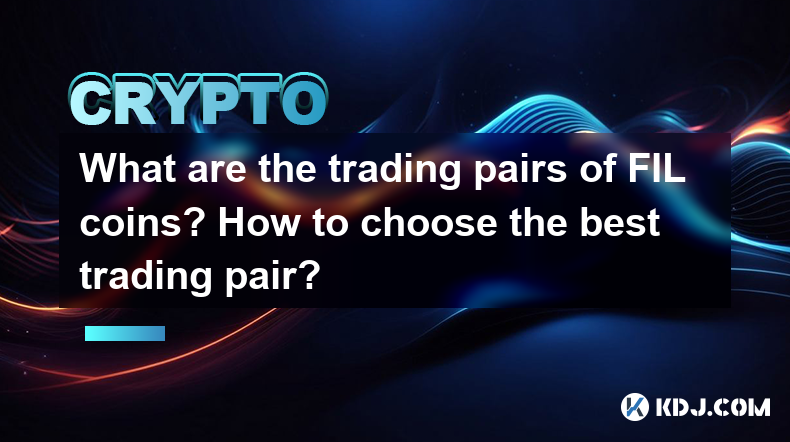
The trading pairs of FIL coins are an essential aspect of engaging with the Filecoin ecosystem. FIL, the native token of the Filecoin network, can be traded against various cryptocurrencies and fiat currencies on numerous exchanges. Understanding these trading pairs and selecting the best one for your trading needs involves considering several factors, including liquidity, trading volume, and fees. In this article, we will explore the available trading pairs for FIL and provide a detailed guide on how to choose the best trading pair.
What are FIL Trading Pairs?
A trading pair is a combination of two assets that can be exchanged on a cryptocurrency exchange. For FIL, trading pairs include combinations with other cryptocurrencies like Bitcoin (BTC), Ethereum (ETH), and stablecoins like USDT (Tether) and USDC (USD Coin). Additionally, some exchanges offer FIL trading pairs with fiat currencies such as USD and EUR.
Common FIL Trading Pairs
Here are some of the most common trading pairs for FIL:
- FIL/BTC: This pair allows you to trade FIL against Bitcoin. It is popular among traders who prefer using Bitcoin as a base currency.
- FIL/ETH: This pair involves trading FIL against Ethereum, another major cryptocurrency.
- FIL/USDT: This is one of the most liquid pairs, as USDT is a stablecoin pegged to the US dollar, making it a stable base for trading.
- FIL/USDC: Similar to FIL/USDT, this pair uses USDC, another stablecoin, as the base currency.
- FIL/USD: This pair allows direct trading of FIL against the US dollar, available on exchanges that support fiat trading.
How to Choose the Best FIL Trading Pair
Choosing the best FIL trading pair involves several considerations. Here are the key factors to keep in mind:
Liquidity
Liquidity is crucial as it affects how easily you can enter and exit trades. A highly liquid pair will have a narrow bid-ask spread, meaning you can buy and sell FIL at prices close to the market rate. To check the liquidity of a trading pair, look at the order book depth on the exchange. Pairs like FIL/USDT and FIL/USDC are typically more liquid due to the stability and widespread use of these stablecoins.
Trading Volume
Trading volume indicates the total amount of FIL traded over a specific period. Higher trading volumes usually correlate with higher liquidity and less price volatility. You can find the trading volume of different FIL pairs on the exchange's trading page or through third-party analytics platforms. FIL/USDT often has the highest trading volume among FIL pairs.
Fees
Trading fees can significantly impact your profitability, especially if you are a frequent trader. Exchanges charge fees for both makers (those who add liquidity to the market) and takers (those who take liquidity from the market). Compare the fee structures of different exchanges and trading pairs to find the most cost-effective option. Some exchanges offer lower fees for trading pairs involving stablecoins.
Volatility
Volatility refers to the price fluctuations of FIL. Pairs with high volatility can offer greater profit potential but also come with higher risk. If you prefer a more stable trading environment, consider pairs like FIL/USDT or FIL/USDC, which tend to be less volatile due to the stability of the base currency.
Exchange Support
Exchange support is another factor to consider. Not all exchanges offer the same FIL trading pairs. Some exchanges might specialize in certain pairs or have better support for FIL trading. Research the exchanges available to you and their FIL trading pairs to find the best fit for your trading strategy.
How to Start Trading FIL
Once you have chosen the best FIL trading pair, you can start trading. Here are the steps to follow:
- Choose an Exchange: Select a reputable cryptocurrency exchange that supports your chosen FIL trading pair. Popular exchanges for FIL trading include Binance, Coinbase Pro, and Kraken.
- Create an Account: Sign up for an account on the chosen exchange. You will need to provide personal information and complete the verification process.
- Deposit Funds: Deposit the cryptocurrency or fiat currency you intend to use as the base for your FIL trading pair. Follow the exchange's instructions to transfer funds to your account.
- Navigate to the Trading Page: Once your account is funded, navigate to the trading page for your chosen FIL pair. This is where you will place your buy and sell orders.
- Place an Order: Decide whether you want to place a market order (executed at the current market price) or a limit order (executed at a specified price). Enter the amount of FIL you want to buy or sell and submit the order.
- Monitor and Manage Your Trades: Keep an eye on your trades and the market conditions. Use stop-loss orders to limit potential losses and take-profit orders to secure gains.
Frequently Asked Questions
Q: Can I trade FIL on decentralized exchanges (DEXs)?
A: Yes, FIL can be traded on decentralized exchanges such as Uniswap and SushiSwap. These platforms allow you to trade FIL against other cryptocurrencies without the need for a centralized intermediary. However, the liquidity and trading volume on DEXs may be lower compared to centralized exchanges.
Q: Are there any risks associated with trading FIL?
A: Yes, trading FIL, like any cryptocurrency, comes with risks. These include market volatility, liquidity risks, and the potential for exchange hacks or scams. It's important to conduct thorough research and only trade with funds you can afford to lose.
Q: How can I stay updated on FIL trading pairs and market conditions?
A: To stay updated on FIL trading pairs and market conditions, you can use cryptocurrency news websites, follow FIL-specific social media channels, and use trading platforms that offer real-time market data and analysis tools. Additionally, joining FIL trading communities can provide insights and updates from other traders.
Q: Can I trade FIL with leverage?
A: Some exchanges offer margin trading or futures trading for FIL, allowing you to trade with leverage. This can amplify both potential profits and losses, so it's important to understand the risks involved and use leverage cautiously.
Disclaimer:info@kdj.com
The information provided is not trading advice. kdj.com does not assume any responsibility for any investments made based on the information provided in this article. Cryptocurrencies are highly volatile and it is highly recommended that you invest with caution after thorough research!
If you believe that the content used on this website infringes your copyright, please contact us immediately (info@kdj.com) and we will delete it promptly.
- Vitalik Buterin Proposes Bitcoin-Like Simplicity for Ethereum
- 2025-05-04 20:20:12
- Bitcoin Has Reached Its $100,000 Threshold as the Cryptocurrency Market Sustains Its All-Time High Pace Upward
- 2025-05-04 20:20:12
- As 2025 approaches, market sentiment is turning bullish for select altcoins with real-world potential.
- 2025-05-04 20:15:12
- Shiba Inu (SHIB) Quietly Building Momentum Despite Recent Short-Term Declines, Pointing to a Potential Breakout
- 2025-05-04 20:15:12
- In the Ever-Volatile World of Crypto, Rumors Can Spread Like Wildfire—and This Week, One Headline Took Center Stage
- 2025-05-04 20:10:17
- Shiba Inu (SHIB) Price Breakout Sparks Rally Speculation
- 2025-05-04 20:10:17
Related knowledge
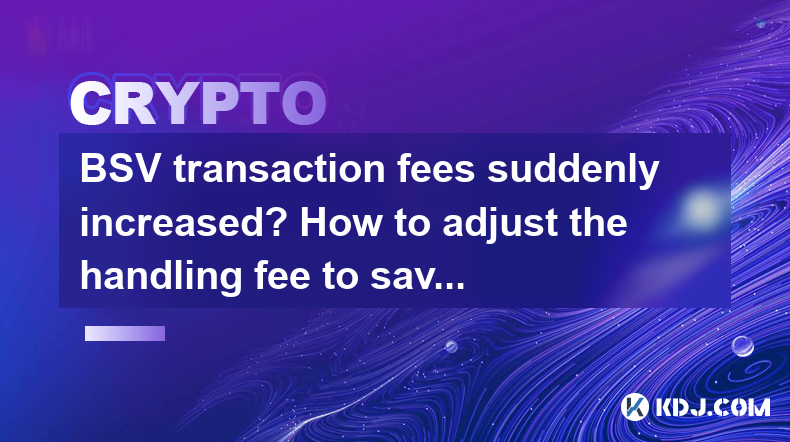
BSV transaction fees suddenly increased? How to adjust the handling fee to save costs?
May 02,2025 at 06:42am
Understanding BSV Transaction FeesBSV (Bitcoin SV) aims to fulfill the original vision of Bitcoin as a peer-to-peer electronic cash system. One of the key elements in this system is the transaction fee, which compensates miners for including transactions in the blockchain. Recently, users have noticed a sudden increase in BSV transaction fees, which can...
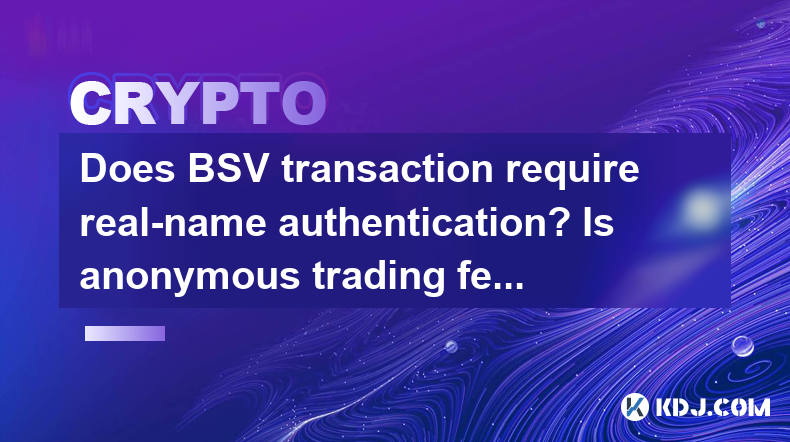
Does BSV transaction require real-name authentication? Is anonymous trading feasible?
May 03,2025 at 03:14pm
The question of whether BSV (Bitcoin SV) transactions require real-name authentication and whether anonymous trading is feasible is a complex one, deeply intertwined with the broader dynamics of cryptocurrency regulations and blockchain technology. Let's delve into these aspects to provide a comprehensive understanding. Understanding BSV and Its Transac...
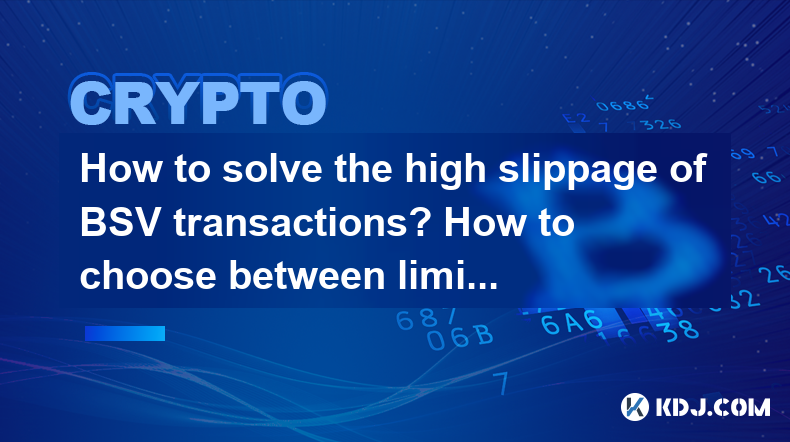
How to solve the high slippage of BSV transactions? How to choose between limit and market orders?
May 02,2025 at 09:01pm
High slippage can be a significant concern for traders dealing with Bitcoin SV (BSV) transactions. Slippage refers to the difference between the expected price of a trade and the price at which the trade is actually executed. This can occur in fast-moving markets or when there is low liquidity. To address this issue, understanding the mechanics of slipp...
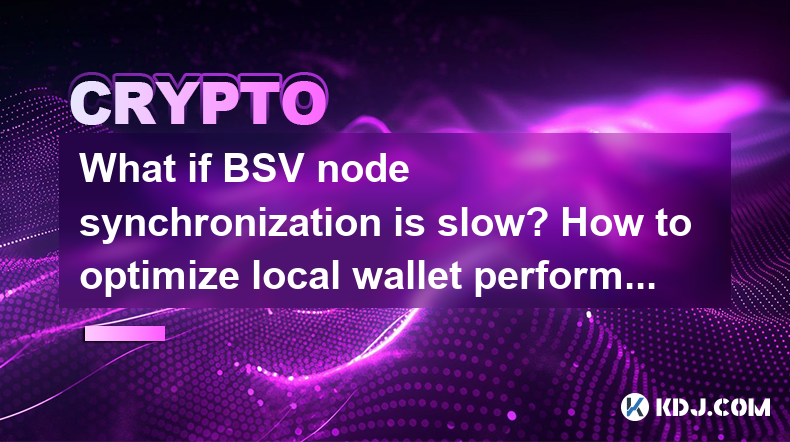
What if BSV node synchronization is slow? How to optimize local wallet performance?
May 03,2025 at 04:35pm
When dealing with BSV (Bitcoin SV) node synchronization and optimizing local wallet performance, it's crucial to understand the underlying issues and implement effective solutions. Slow synchronization and poor wallet performance can significantly hinder your experience with the BSV network. This article will delve into the reasons behind slow BSV node ...
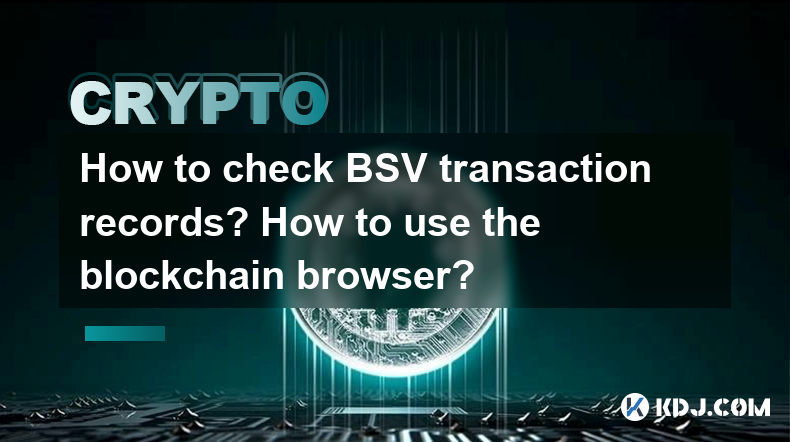
How to check BSV transaction records? How to use the blockchain browser?
May 03,2025 at 06:50am
Checking BSV (Bitcoin SV) transaction records and using a blockchain browser are essential skills for anyone involved in the cryptocurrency space. These tools allow you to verify transactions, check wallet balances, and understand the flow of funds on the blockchain. This article will guide you through the process of checking BSV transaction records and...
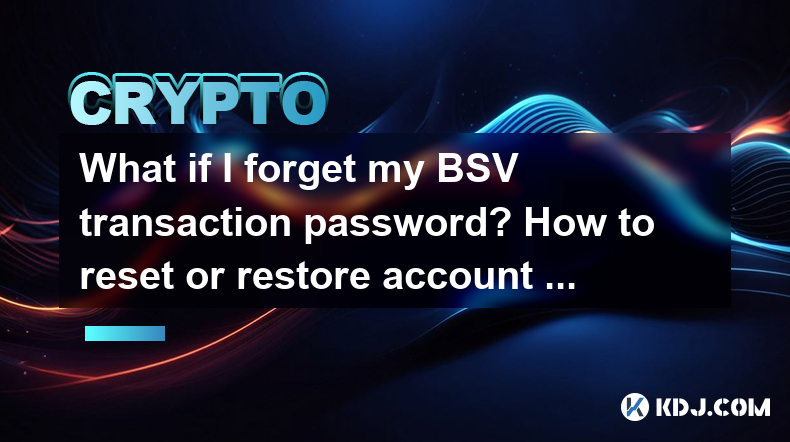
What if I forget my BSV transaction password? How to reset or restore account permissions?
May 02,2025 at 02:49pm
Forgetting your BSV (Bitcoin SV) transaction password can be a stressful experience, but there are steps you can take to reset or restore your account permissions. This article will guide you through the process, ensuring you understand each step and potential solutions available to you. Understanding BSV Transaction PasswordsBSV transaction passwords a...

BSV transaction fees suddenly increased? How to adjust the handling fee to save costs?
May 02,2025 at 06:42am
Understanding BSV Transaction FeesBSV (Bitcoin SV) aims to fulfill the original vision of Bitcoin as a peer-to-peer electronic cash system. One of the key elements in this system is the transaction fee, which compensates miners for including transactions in the blockchain. Recently, users have noticed a sudden increase in BSV transaction fees, which can...

Does BSV transaction require real-name authentication? Is anonymous trading feasible?
May 03,2025 at 03:14pm
The question of whether BSV (Bitcoin SV) transactions require real-name authentication and whether anonymous trading is feasible is a complex one, deeply intertwined with the broader dynamics of cryptocurrency regulations and blockchain technology. Let's delve into these aspects to provide a comprehensive understanding. Understanding BSV and Its Transac...

How to solve the high slippage of BSV transactions? How to choose between limit and market orders?
May 02,2025 at 09:01pm
High slippage can be a significant concern for traders dealing with Bitcoin SV (BSV) transactions. Slippage refers to the difference between the expected price of a trade and the price at which the trade is actually executed. This can occur in fast-moving markets or when there is low liquidity. To address this issue, understanding the mechanics of slipp...

What if BSV node synchronization is slow? How to optimize local wallet performance?
May 03,2025 at 04:35pm
When dealing with BSV (Bitcoin SV) node synchronization and optimizing local wallet performance, it's crucial to understand the underlying issues and implement effective solutions. Slow synchronization and poor wallet performance can significantly hinder your experience with the BSV network. This article will delve into the reasons behind slow BSV node ...

How to check BSV transaction records? How to use the blockchain browser?
May 03,2025 at 06:50am
Checking BSV (Bitcoin SV) transaction records and using a blockchain browser are essential skills for anyone involved in the cryptocurrency space. These tools allow you to verify transactions, check wallet balances, and understand the flow of funds on the blockchain. This article will guide you through the process of checking BSV transaction records and...

What if I forget my BSV transaction password? How to reset or restore account permissions?
May 02,2025 at 02:49pm
Forgetting your BSV (Bitcoin SV) transaction password can be a stressful experience, but there are steps you can take to reset or restore your account permissions. This article will guide you through the process, ensuring you understand each step and potential solutions available to you. Understanding BSV Transaction PasswordsBSV transaction passwords a...
See all articles





















































































